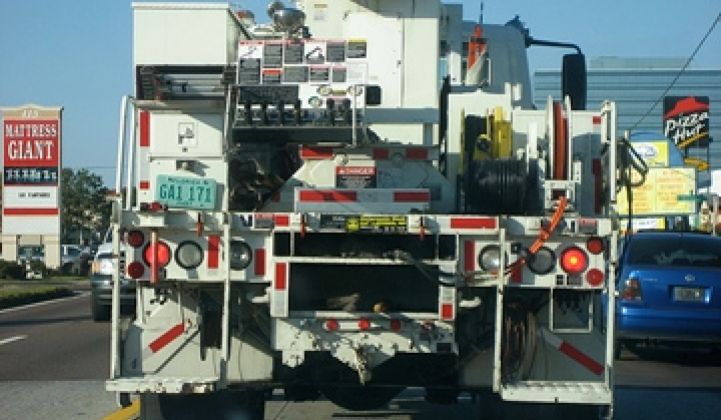The smart grid may be a high-tech junkie's dream, but it starts paying off first by cutting energy wasted in low-tech ways of doing business.
Take truck rolls – the term for sending utility workers in trucks to read meters, turn service on and off, fix broken transformers, throw switches to fix power outages, and the like.
The energy savings, and environmental benefits, of reducing those truck rolls shouldn't be written off in calculating the smart grid's impact on a utility's environmental footprint, according to Linda Jackman, vice president of product management for Oracle's utilities division (see Green Light post).
After all, trucks burn diesel, which costs money and yields greenhouse-gas emissions, Jackman said Wednesday at Greentech Media's The Networked Grid conference.
Smart meters, for example, save utilities money first by allowing them to stop sending out meter readers to drive from house to house.
Later on, of course, those two-way communication meters may serve as conduits for utilities to connect to customers with variable pricing schemes and demand response controls to help cut home energy use.
But other add-on features, such as turning a service on and off remotely and using meters to find out where outages are, can also save on truck rolls in the shorter term, Pacific Gas & Electric spokesman Paul Moreno said.
PG&E has installed about four million smart meters out of a 10 million meter deployment, and is rolling them out at a rate of about 12,000 to 15,000 a day, or one every two seconds, Andrew Tang, senior director of the utility's "smart energy web" efforts, said Wednesday (see PG&E's Smart Grid Challenges and Solutions by the Region).
About 850 meter readers now work for the utility, but they've been offered retraining and given money for it as part of the utility's smart meter plan before the state's Public Utility Commission, Moreno said. While some of them walk to work, many drive utility trucks or personal vehicles, he said.
North American utilities are expected to replace about half of their roughly 120 million electricity meters with smart meters by 2015, according to Pike Research (see Green Light post). That could yield big of savings on truck rolls and labor costs – though utilities are no doubt negotiating the latter issue with their labor unions, as PG&E has.
Utilities can be compelled to upgrade to smart grid technologies through government regulation as well, Jackman added.
Take the case of Australian utility Jemena Electricity Networks, which has installed distribution grid gear to automate the switch-throwing processes that isolate and restore faults – things like downed power lines or transformers shorted out by squirrels that cause power outages.
By government decree, Jemena now has to keep those outages to less than a minute or face fines, Jackman, an Australian native, said. That's pushed the utility to convert its 72,000 square miles of territory into what she called a "self-healing grid," capable of finding and fixing problems remotely in that sub-minute timeframe, she said.
It's important not to let the small percentage-point improvements in reliability fool you, Jackman said. Spread across massive energy delivery infrastructures, those small gains add up.
One example comes from a report this week from the Utilities Telecom Council (hat tip Smart Grid News) that says that smart grid upgrades – modeled on a generic one-million smart meter deployment, along with distribution automation and some distributed energy resources – can improve overall grid reliability from 99.48 percent to 99.75 percent.
But that quarter percentage-point improvement can reduce outage minutes by 16.8 million customer minutes – that's 16.8 minutes per customer. It also can increase the internal rate of return on the investment from 14 percent to 35 percent or greater, if customers realize the economic value of reduced minutes without power, the report said.
Other utilities are deploying smart distribution grid systems, though they've been less prevalent in the list of projects being funded with billions of dollars in federal stimulus grants (see and Distribution Automation: Smart Grid's Quiet Efficiency Offering).
The same generic smart meter deployment should also be able to reduce carbon dioxide emissions by about 300,000, the report said. That opens up the question of how smart grid technologies might play into utilities' overall carbon footprints – an issue that carbon cap-and-trade legislation might bring to the forefront (see Green Light post).
The Environmental Protection Agency – which is seeking authority to regulate greenhouse gas emissions under the Clean Air Act – is interested in tracking utility industry efforts to set standards to verify the environmental improvements of smart grid systems, EPA's Stacy Angel said in a Thursday conference call with the Electric Power Research Institute.
Photo via Flickr/Creative Commons.



